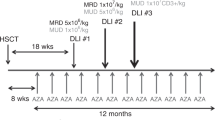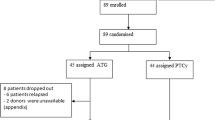Abstract
We have piloted a low-dose schedule of 5-azacytidine followed by donor lymphocyte infusions (DLIs) in patients with relapse of AML or chronic myelomonocytic leukemia (CMMoL) after allografting. Of the 26 patients (median age 62 years, range 28–75) with relapsed AML (n=24) or CMMoL (n=2), 11 (42%) had poor-risk cytogenetics. Twenty-three patients had received fludarabine-based reduced-toxicity conditioning regimens, and three had received conventional myeloablative conditioning. Patients received 5-azacytidine s.c., at a total daily dose of 100 mg, on days 1–3, to be followed by DLI on day 10, with the next course of treatment to be started on day 22. A total of 60 courses of 5-azacytidine were administered, with a median of 2 courses (range: 1–10). In 44 courses, 5-azacytidine was followed by DLI, and thus 19/26 (73%) patients received at least one course of this combined treatment. Clinically relevant neutropenic infections not associated with progressive disease developed in four patients, one of them succumbing to sepsis. Only two patients developed de novo acute GvHD after the combination of 5-azacytidine and DLI. Overall, 66% of the patients benefited from this treatment, with continued CRs achieved in 4 (16%) patients, lasting a median of 525 days (range: 450+ to 820+), and a 50% rate of temporary disease control with stable mixed chimerism (median duration 72 days). The median survival from the start of 5-azacytidine treatment was 136 days (range: 23 to 873+), with an estimated 2-year survival probability of 16%. In conclusion, this non-intensive outpatient regimen of 5-azacytidine followed by DLI is feasible, with a very low aGVHD rate. Objective responses, including continuous complete donor chimerism, occurred also in patients with poor-risk cytogenetics.
This is a preview of subscription content, access via your institution
Access options
Subscribe to this journal
Receive 12 print issues and online access
$259.00 per year
only $21.58 per issue
Buy this article
- Purchase on Springer Link
- Instant access to full article PDF
Prices may be subject to local taxes which are calculated during checkout

Similar content being viewed by others
References
Claus R, Lübbert M . Epigenetic targets in hematopoietic malignancies. Oncogene 2003; 22: 6489–6496.
Coral S, Sigalotti L, Covre A, Nicolay HJ, Natali PG, Maio M . 5-Aza-2′-deoxycytidine in cancer immunotherapy: a mouse to man story. Cancer Res 2007; 67: 2900–2901; author reply 2901–2902.
Fenaux P, Mufti GJ, Hellstrom-Lindberg E, Santini V, Finelli C, Giagounidis A et al. Efficacy of azacitidine compared with that of conventional care regimens in the treatment of higher-risk myelodysplastic syndromes: a randomised, open-label, phase III study. Lancet Oncol 2009; 10: 223–232.
Wijermans P, Lübbert M, Verhoef G, Bosly A, Ravoet C, Andre M et al. Low-dose 5-aza-2′-deoxycytidine, a DNA hypomethylating agent, for the treatment of high-risk myelodysplastic syndrome: a multicenter phase II study in elderly patients. J Clin Oncol 2000; 18: 956–962.
Pinto A, Maio M, Attadia V, Zappacosta S, Cimino R . Modulation of HLA-DR antigens expression in human myeloid leukaemia cells by cytarabine and 5-aza-2′-deoxycytidine. Lancet 1984; 2: 867–868.
Sigalotti L, Altomonte M, Colizzi F, Degan M, Rupolo M, Zagonel V et al. 5-Aza-2′-deoxycytidine (decitabine) treatment of hematopoietic malignancies: a multimechanism therapeutic approach? Blood 2003; 101: 4644–4646; discussion 4645–4646.
Soiffer RJ . Donor lymphocyte infusions for acute myeloid leukaemia. Best Pract Res Clin Haematol 2008; 21: 455–466.
Kolb HJ, Mittermüller J, Clemm C, Holler E, Ledderose G, Brehm G et al. Donor leukocyte transfusions for treatment of recurrent chronic myelogenous leukemia in marrow transplant patients. Blood 1990; 76: 2462–2465.
Eapen M, Giralt SA, Horowitz MM, Klein JP, Wagner JE, Zhang MJ et al. Second transplant for acute and chronic leukemia relapsing after first HLA-identical sibling transplant. Bone Marrow Transplant 2004; 34: 721–727.
Grüllich C, Bertz H, Spyridonidis A, Müller CI, Finke J . A fludarabine, thiotepa reduced toxicity conditioning regimen designed specifically for allogeneic second haematopoietic cell transplantation after failure of previous autologous or allogeneic transplantation. Bone Marrow Transplant 2008; 41: 845–850.
Collins Jr RH, Shpilberg O, Drobyski WR, Porter DL, Giralt S, Champlin R et al. Donor leukocyte infusions in 140 patients with relapsed malignancy after allogeneic bone marrow transplantation. J Clin Oncol 1997; 15: 433–444.
Schmid C, Labopin M, Nagler A, Bornhäuser M, Finke J, Fassas A et al. Donor lymphocyte infusion in the treatment of first hematological relapse after allogeneic stem-cell transplantation in adults with acute myeloid leukemia: a retrospective risk factors analysis and comparison with other strategies by the EBMT Acute Leukemia Working Party. J Clin Oncol 2007; 25: 4938–4945.
Nadal E, Fowler A, Kanfer E, Apperley J, Goldman J, Dazzi F . Adjuvant interleukin-2 therapy for patients refractory to donor lymphocyte infusions. Exp Hematol 2004; 32: 218–223.
Schmid C, Schleuning M, Aschan J, Ringden O, Hahn J, Holler E et al. Low-dose ARAC, donor cells, and GM-CSF for treatment of recurrent acute myeloid leukemia after allogeneic stem cell transplantation. Leukemia 2004; 18: 1430–1433.
de Lima M, Ravandi F, Shahjahan M, Andersson B, Couriel D, Donato M et al. Long-term follow-up of a phase I study of high-dose decitabine, busulfan, and cyclophosphamide plus allogeneic transplantation for the treatment of patients with leukemias. Cancer 2003; 97: 1242–1247.
Ravandi F, Kantarjian H, Cohen A, Davis M, O’Brien S, Anderlini P et al. Decitabine with allogeneic peripheral blood stem cell transplantation in the therapy of leukemia relapse following a prior transplant: results of a phase I study. Bone Marrow Transplant 2001; 27: 1221–1225.
Graef T, Kuendgen A, Fenk R, Zohren F, Haas R, Kobbe G . Successful treatment of relapsed AML after allogeneic stem cell transplantation with azacitidine. Leuk Res 2007; 31: 257–259.
Charache S, Dover G, Smith K, Talbot Jr CC, Moyer M, Boyer S . Treatment of sickle cell anemia with 5-azacytidine results in increased fetal hemoglobin production and is associated with nonrandom hypomethylation of DNA around the gamma-delta-beta-globin gene complex. Proc Natl Acad Sci USA 1983; 80: 4842–4846.
Lübbert M, Bertz H, Ruter B, Marks R, Claus R, Wasch R et al. Non-intensive treatment with low-dose 5-aza-2′-deoxycytidine (DAC) prior to allogeneic blood SCT of older MDS/AML patients. Bone Marrow Transplant 2009(e-pub ahead of print 13 April 2009; doi:10.1038/bmt.2009.64).
Bertz H, Potthoff K, Finke J . Allogeneic stem-cell transplantation from related and unrelated donors in older patients with myeloid leukemia. J Clin Oncol 2003; 21: 1480–1484.
Fröhling S, Schlenk RF, Breitruck J, Benner A, Kreitmeier S, Tobis K et al. Prognostic significance of activating FLT3 mutations in younger adults (16–60 years) with acute myeloid leukemia and normal cytogenetics: a study of the AML Study Group Ulm. Blood 2002; 100: 4372–4380.
Spyridonidis A, Bertz H, Waterhouse M, Finke J . Long-term lymphoid-restricted split chimerism after myeloablative allogeneic BMT for bcr-abl+ ALL. Bone Marrow Transplant 2008; 42: 829–831.
Levine JE, Braun T, Penza SL, Beatty P, Cornetta K, Martino R et al. Prospective trial of chemotherapy and donor leukocyte infusions for relapse of advanced myeloid malignancies after allogeneic stem-cell transplantation. J Clin Oncol 2002; 20: 405–412.
Porter DL, Levine BL, Bunin N, Stadtmauer EA, Luger SM, Goldstein S et al. A phase 1 trial of donor lymphocyte infusions expanded and activated ex vivo via CD3/CD28 costimulation. Blood 2006; 107: 1325–1331.
Lübbert M, Wijermans P, Kunzmann R, Verhoef G, Bosly A, Ravoet C et al. Cytogenetic responses in high-risk myelodysplastic syndrome following low-dose treatment with the DNA methylation inhibitor 5-aza-2′-deoxycytidine. Br J Haematol 2001; 114: 349–357.
Boehm TL, Drahovsky D . Elevated level of enzymatic DNA methylation in cells treated with 1-beta-D-arabinofuranosylcytosine. Cancer Res 1982; 42: 1537–1540.
Flotho C, Claus R, Batz C, Schneider M, Sandrock I, Ihde S et al. The DNA methyltransferase inhibitors azacitidine, decitabine and zebularine exert differential effects on cancer gene expression in acute myeloid leukemia cells. Leukemia 2009; 23: 1019–1028.
Almstedt M, Blagitko-Dorfs N, Duque-Afonso J, Pfeifer D, Lübbert M . Treatment with the DNA methyltransferase inhibitor 5-aza-2′-deoxycytidine mediates derepression of x-chromosomally located cancer testis antigens in myeloid cell lines. Leuk Res (under revision).
Gore SD, Baylin S, Sugar E, Carraway H, Miller CB, Carducci M et al. Combined DNA methyltransferase and histone deacetylase inhibition in the treatment of myeloid neoplasms. Cancer Res 2006; 66: 6361–6369.
Daskalakis M, Nguyen TT, Nguyen C, Guldberg P, Kohler G, Wijermans P et al. Demethylation of a hypermethylated P15/INK4B gene in patients with myelodysplastic syndrome by 5-aza-2′-deoxycytidine (decitabine) treatment. Blood 2002; 100: 2957–2964.
Gore SD, Hermes-DeSantis ER . Future directions in myelodysplastic syndrome: newer agents and the role of combination approaches. Cancer Control 2008; 15 (Suppl): 40–49.
Fabre C, Grosjean J, Tailler M, Boehrer S, Adès L, Perfettini JL et al. A novel effect of DNA methyltransferase and histone deacetylase inhibitors: NF-kappaB inhibition in malignant myeloblasts. Cell Cycle 2008; 7: 2139–2145.
Khan R, Schmidt-Mende J, Karimi M, Gogvadze V, Hassan M, Ekstrom TJ et al. Hypomethylation and apoptosis in 5-azacytidine-treated myeloid cells. Exp Hematol 2008; 36: 149–157.
Acknowledgements
We thank Irmgard Matt for excellent support with data acquisition; Sara Cohen, Ljudmilla Bogatyreva, Gabriele Ihorst, Claudia Schmoor and Thilo Hübsch for expert help with biostatistics; and Lydia Krause and Carol Cuerten for help with editing of this paper. We are grateful to the reviewers of the paper for providing many helpful suggestions.
Author information
Authors and Affiliations
Corresponding authors
Rights and permissions
About this article
Cite this article
Lübbert, M., Bertz, H., Wäsch, R. et al. Efficacy of a 3-day, low-dose treatment with 5-azacytidine followed by donor lymphocyte infusions in older patients with acute myeloid leukemia or chronic myelomonocytic leukemia relapsed after allografting. Bone Marrow Transplant 45, 627–632 (2010). https://doi.org/10.1038/bmt.2009.222
Received:
Revised:
Accepted:
Published:
Issue Date:
DOI: https://doi.org/10.1038/bmt.2009.222
Keywords
This article is cited by
-
Second unmanipulated allogeneic transplantation could be used as a salvage option for patients with relapsed acute leukemia post-chemotherapy plus modified donor lymphocyte infusion
Frontiers of Medicine (2021)
-
Prospective phase II study of prophylactic low-dose azacitidine and donor lymphocyte infusions following allogeneic hematopoietic stem cell transplantation for high-risk acute myeloid leukemia and myelodysplastic syndrome
Bone Marrow Transplantation (2019)
-
Hypomethylating agents for treatment and prevention of relapse after allogeneic blood stem cell transplantation
International Journal of Hematology (2018)
-
Treatment of relapsed AML and MDS after allogeneic stem cell transplantation with decitabine and DLI—a retrospective multicenter analysis on behalf of the German Cooperative Transplant Study Group
Annals of Hematology (2018)
-
Low-dose 5-azacytidine as preventive therapy for relapse of AML and MDS following allogeneic HCT
Bone Marrow Transplantation (2017)



